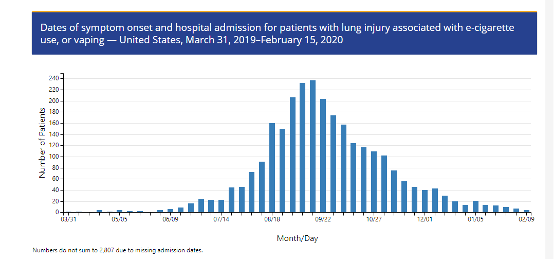Is America’s e-cigarette crisis a smokescreen for the coronavirus outbreak?

Coughing and short of breath, a patient presented to the emergency room with a low blood oxygen level, and the CT scan showed a “ground glass” pattern of white flecks on his lungs, a sign of severe pulmonary damage. Sounds familiar? Well, he wasn’t diagnosed with COVID-19. Instead, the patient was treated as one of the first EVALI (e-cigarette or vaping use-associated lung injury) cases in the U.S. that have mysteriously popped up since March 2019.
Back in 2019, the U.S. Centers for Disease Control and Prevention (CDC) acted quickly to link the unknown pneumonia with the use of e-cigarettes, and the Trump administration later issued a restriction, pulling most flavored e-cigarettes off the shelves. Vitamin E acetate, a synthetic form of vitamin E often used in supplement and skincare products, was deemed as the culprit behind the crisis.
Then came the global pandemic. The puzzles surrounding the mysterious pneumonia, however, have remained unsolved with the fallout of COVID-19.
One major question remains: why did the EVALI crisis suddenly come to the fore in 2019 to become an indigenous epidemic? Invented 18 years ago, e-cigarettes were nothing new at the time, and adding vitamin E acetate into all sorts of products, including e-cigarettes, is an old practice. The timing of the crisis, compounded by the symptoms of the lung disease, leads us to a plausible hypothesis: what if the coronavirus had already been circulating among Americans at that time, under the guise of the EVALI crisis? Or what if coronavirus-infected patients were misdiagnosed as having EVALI?
“Based on symptoms, we were treating them (COVID-19 patients) for the flu as well. Now looking back, a decent amount of that was probably COVID,” said Dr. Miachel Weipert from Immediate Care of The South in an interview with NBC News this February. A recent study conducted by researchers at the University of Washington has also found that the number of COVID-19 cases in the U.S. may have been undercounted by as much as 60%, according to the Guardian.
Likewise, the possibility that COVID-19 could have been circulating in the U.S. as early as the second half of 2019, under the guise of the EVALI crisis, also can’t be ruled out.
Despite several news articles by American media curtly dismissing the possibility because a few patients’ COVID-19 nucleic acid tests came out negative, there is no conclusive evidence such as antibody tests within a large sample group proving that those with EVALI back in 2019 weren’t infected with the coronavirus.
In fact, researchers who studied archived samples from 7,389 routine blood donations collected by the American Red Cross from 13 December 2019 to 17 January 2020 found that 106 were reactive to pan-Ig, one of the anti–SARS-CoV-2 antibodies, which signaled that the first case in the U.S. occurred prior to January 19, 2020, the date the CDC reported the first case in the U.S. The research paper, published on June 15, 2021 in Clinical Infectious Diseases, a prestigious medical journal, offered an idea that further study could look into whether e-cigarettes or coronavirus was to blame for the crisis.
Another hint of doubt is the case numbers and hospital admissions for EVALI. The shape of the curve (see chart) illustrated by the CDC showing the number of patients admitted to the hospital is suspiciously similar to the epidemic curve of an infectious disease like COVID-19 or Ebola, where case numbers and hospitalizations grow steadily for a period before reaching a peak and then flattening.

As of February 18, 2020, all 50 states saw cases of the COVID-like disease, with 2,807 cases and 68 deaths reported, according to the latest data updated by the CDC on February 25, 2020. (Screenshot/CDC)
There are also other big unknowns: e.g., why did some e-cigarette consumers get severely ill while others didn’t? Why did people with no pre-existing conditions fall victim to the disease? Why did European countries like the UK, one of the world’s heaviest e-cigarette smokers, not see so many EVALI cases and deaths?
As some American politicians like Rand Paul and Tom Cotton are so obsessed with getting to the “truth” rather than encouraging people to get vaccinated and put their masks on to guard against the deadly Delta variant, they’d better not neglect any possibility and unleash their full scientific literacy in search of the virus origin in their offices. The land where they live may offer a few clues.
Photos
Related Stories
- COVID-19 origin tracing: Claim emerges of 'intimidation' from the U.S.
- Central Chinese city closes tourist sites, cinemas after new infections emerge
- Chinese COVID-19 vaccines effective against infection, mortality, say experts
- Third shot of Sinovac COVID-19 vaccine gives big boost to immunity: study
- Is mute Fort Detrick 'innocent'?
Copyright © 2021 People's Daily Online. All Rights Reserved.










